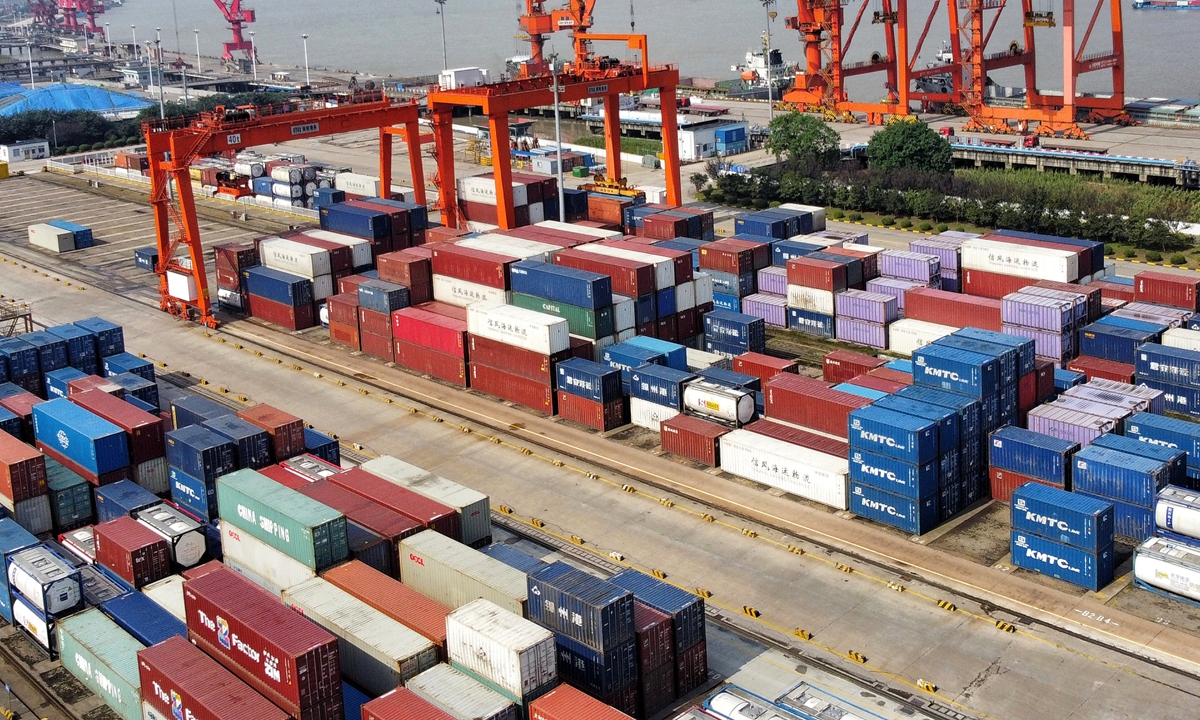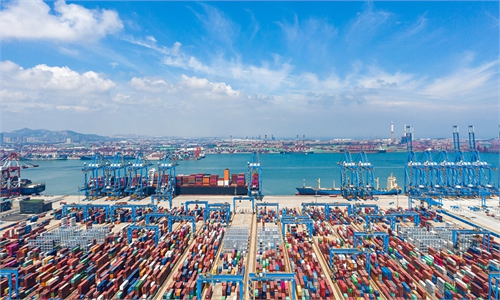Falling shipping rates portend slow growth in China’s foreign trade
Govt efforts, improving orders to support China’s exports

A view of the Zhangjiagang port in East China's Jiangsu Province on October 21. In September, China's exports grew 28.1 percent from the previous year, up 3.9 percentage points from August, data from the General Administration of Customs showed. Photo: cnsphoto
Global sea freight rates witnessed sharp drops in March with some areas down by around 50 percent, an indication of mixed factors, including sluggish global demand driven by the slow recovery from the COVID-19 pandemic, surging US inflation, the Russia-Ukraine conflict and COVID-19 flare-ups in some parts of China.
Judging from the falling shipping rates, sluggish global demand might have dragged down on China's foreign trade in the first quarter, but industry insiders said that the situation will likely improve in May and June as the Chinese government strives to secure supply chains and export orders are expected to surge.
Trans-Pacific container spot rates between China and the US have fallen steadily since peaking in early January, according to digital freight forwarding platform Shifl.
Rates to the West Coast fell 52 percent, and those to the East Coast fell 50 percent.
The weekly Drewry assessment for Shanghai to Los Angeles came in at $8,824 per standard container on Thursday, down 20 percent from early March.
"At the moment [Asia-West Coast] demand is fairly low, almost unseasonably so," George Griffiths, managing editor of global container freight at S&P Global Commodity Insights, told International Shipping News on Monday.
Freight rates are still high on a yearly basis.
For example, freight rates on Shanghai - Los Angeles dropped 3 percent or $288 to $8,824 from March 31 to April 7, while its annual change shows the very opposite - an increase of 110 percent year-on-year, according to Drewry's composite World Container Index.
Many factors have depressed cargo rates, but shrinking global demand is the main one, analysts said.
"Foreign trade last year was supported by booming orders for home appliances and anti-epidemic items, but the situation has eased," Zheng Jingwen, a research fellow at the Shanghai International Shipping Research Center, told the Global Times on Tuesday.
Also, the US government is no longer offering payments as part of its economic stimulus and public consumption ability has not fully recovered, according to Zheng.
Moreover, high US interest rates have brought more uncertainty to global trade, industry insiders said. Surging prices of bulk commodities such as crude oil, driven by the Russia-Ukraine conflict, have further intensified the situation, they added.
Some factory owners in the Yangtze River Delta said their foreign trade orders are down about 50 percent year-on-year.
The epidemic in Shanghai is also affecting trade flows. Although the Shanghai port, the world's largest container port, is still operating, regional lockdowns and traffic closures in neighboring areas are making deliveries difficult. Some 60-70 percent of the cargo deliveries to Shanghai port rely on land transportation, according to Zheng.
The situation is expected to ease as the Chinese central government has launched measures to smooth supply chains.
In an effort to secure supply chains while pursuing the dynamic zero-COVID policy, a notice from the State Council said on Monday that any shutdowns of highway services, port terminals, railway stations or airports without authorization are strictly forbidden, and stopping crew changes on international shipping services without authorization is disallowed.
The measures have already had a positive impact on logistics, traders told the Global Times on Tuesday.
Wu Minghua, an independent shipping industry analyst from Shanghai, told the Global Times on Tuesday that it's not surprising freight rates are falling, since the peak season for shipping normally start from May and June.
"With efforts by the Chinese government to secure the supply chain, foreign trade flows will see a positive change, especially in May when orders for Christmas and the year-end shopping season in the West are about to take place," Wu said.
A person with shipping line Maersk told the Global Times on Tuesday that the big drop was on the spot rate, which has little impact on the company, which focuses more on the long-term contracts that account for 65 percent of its customers.

